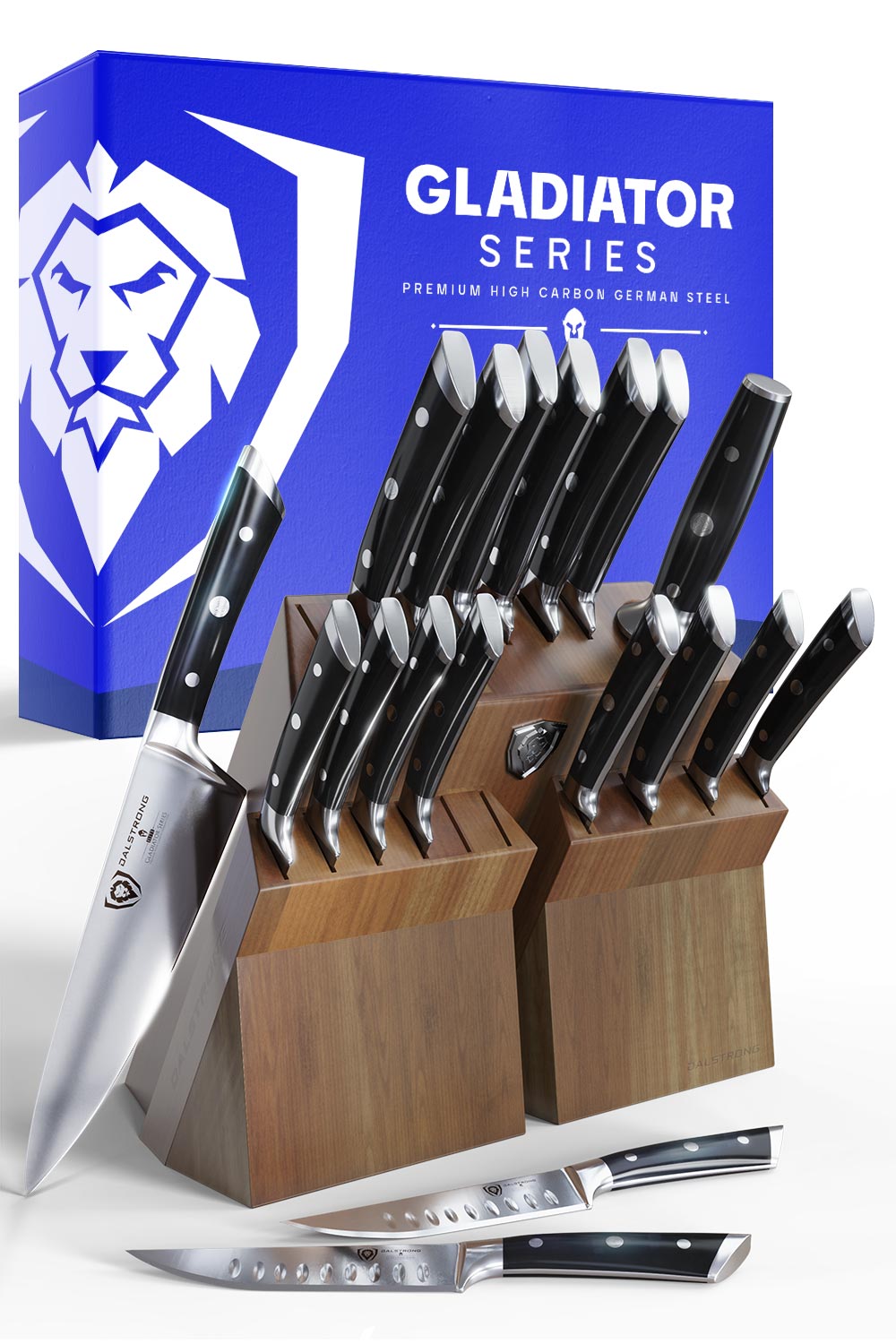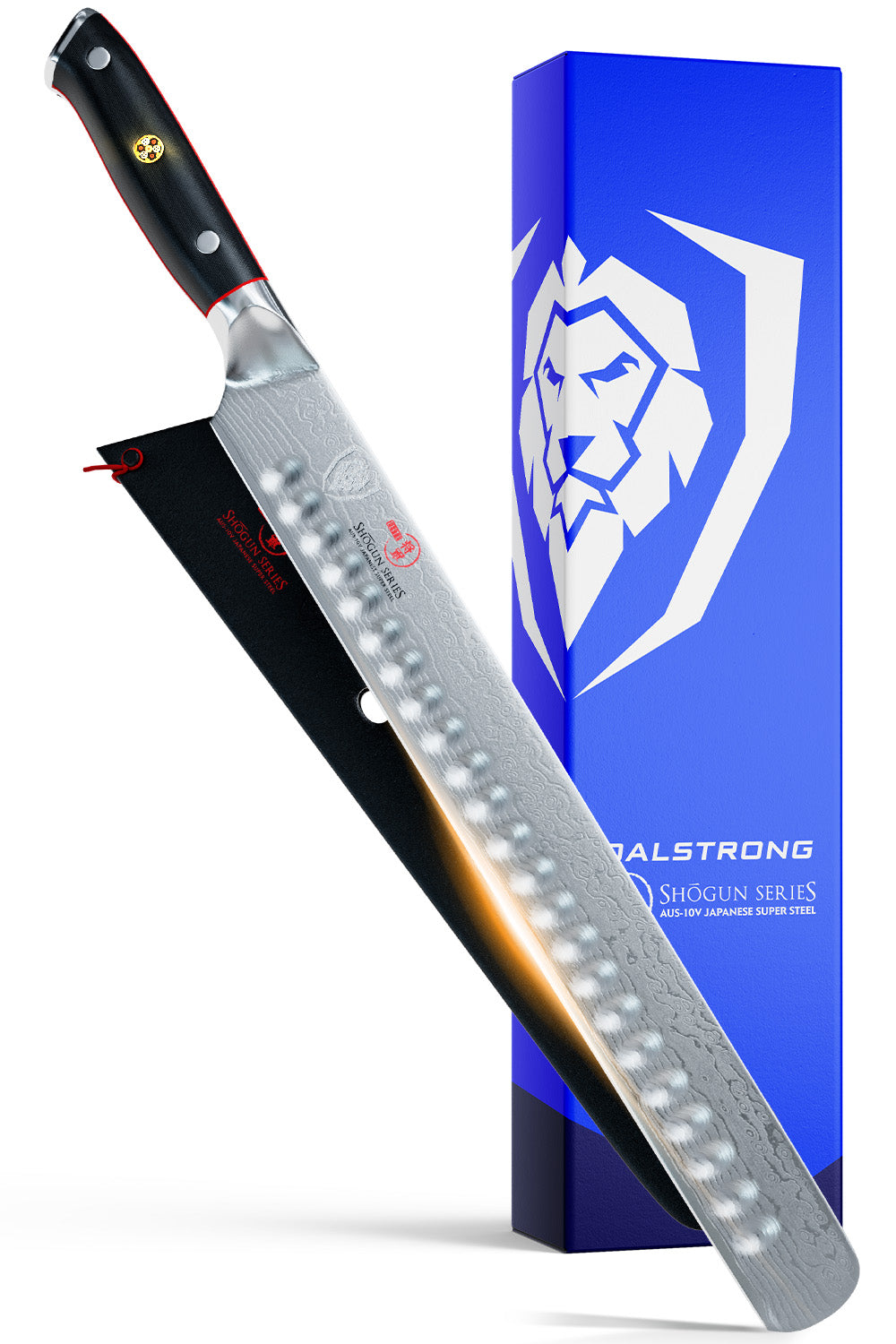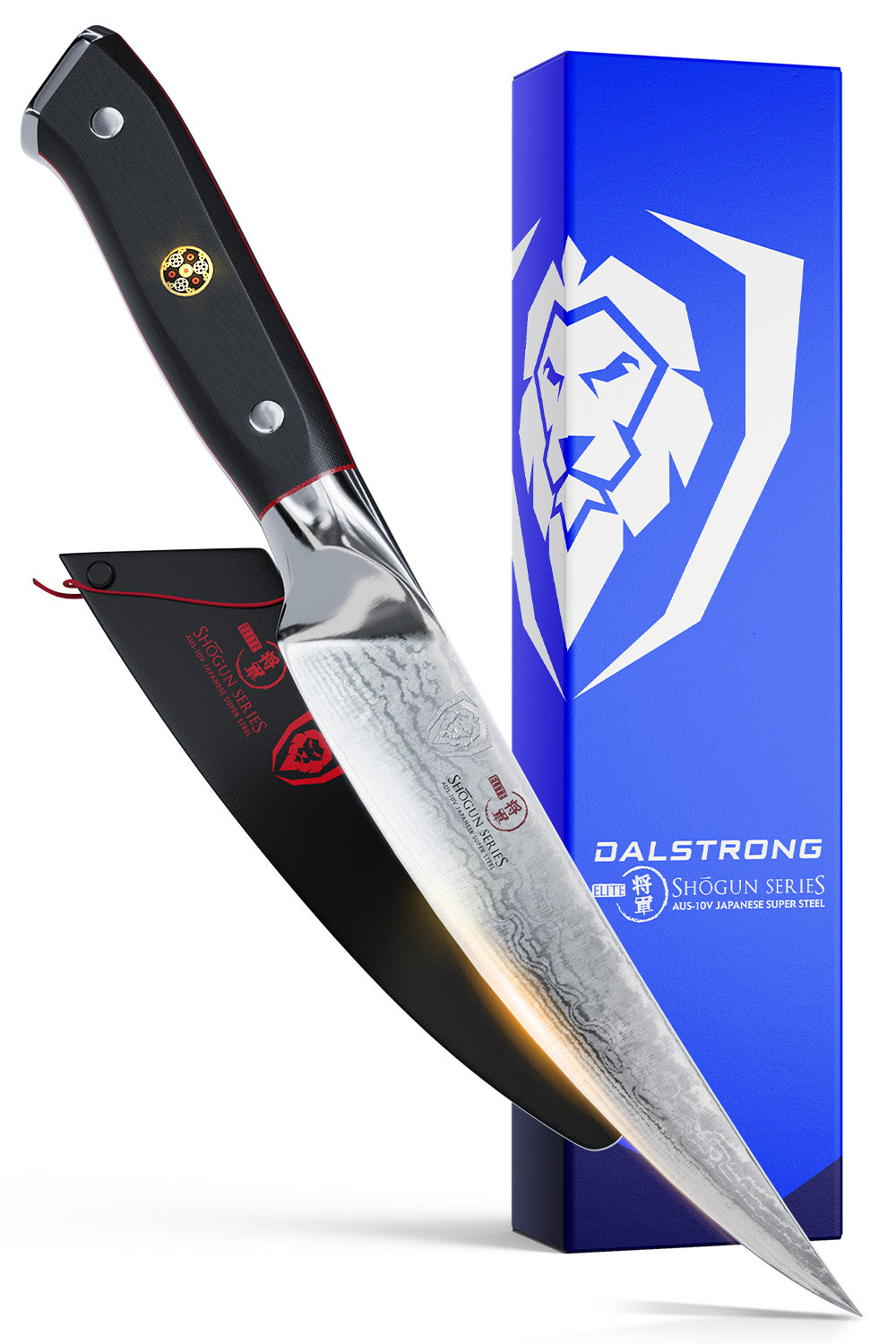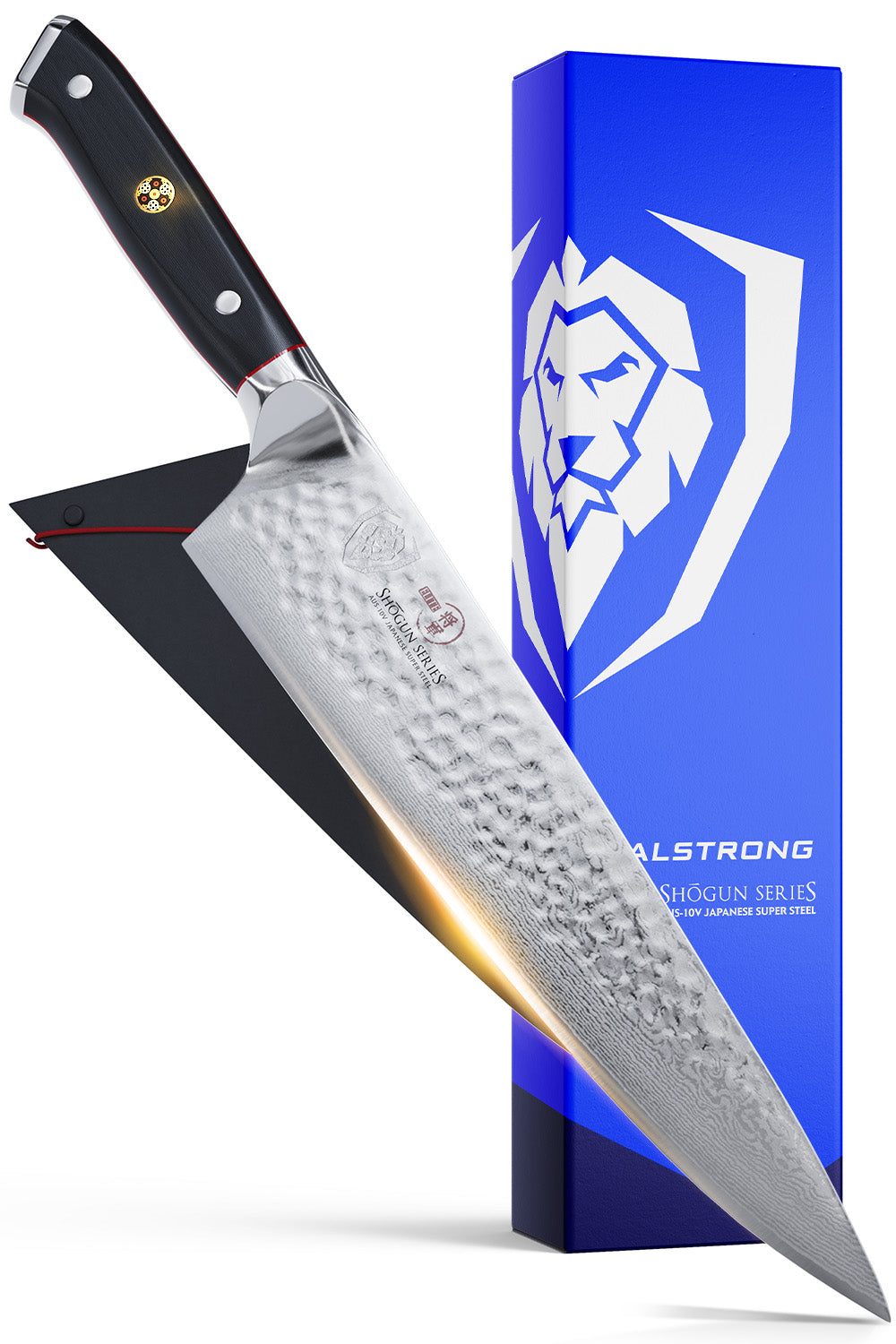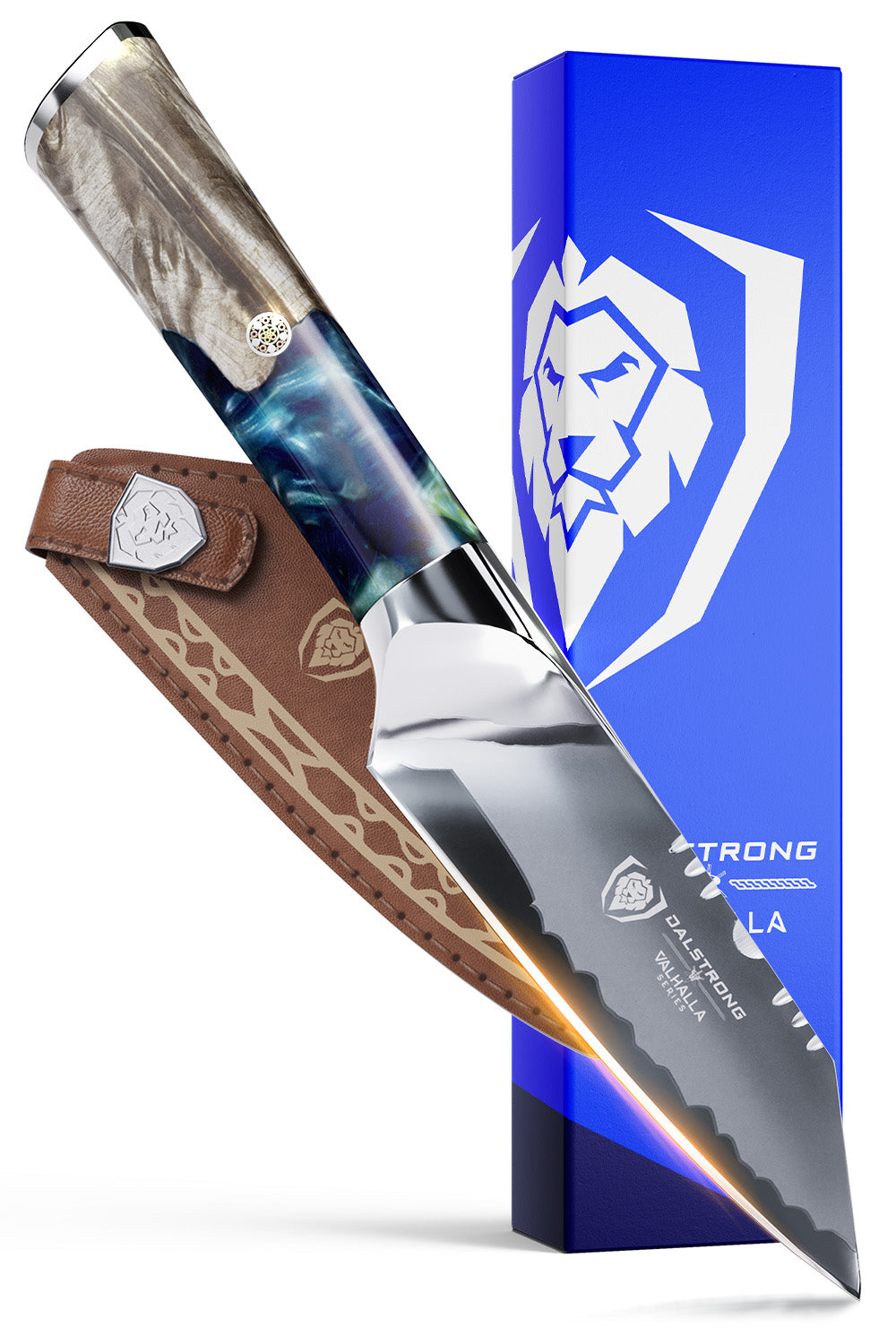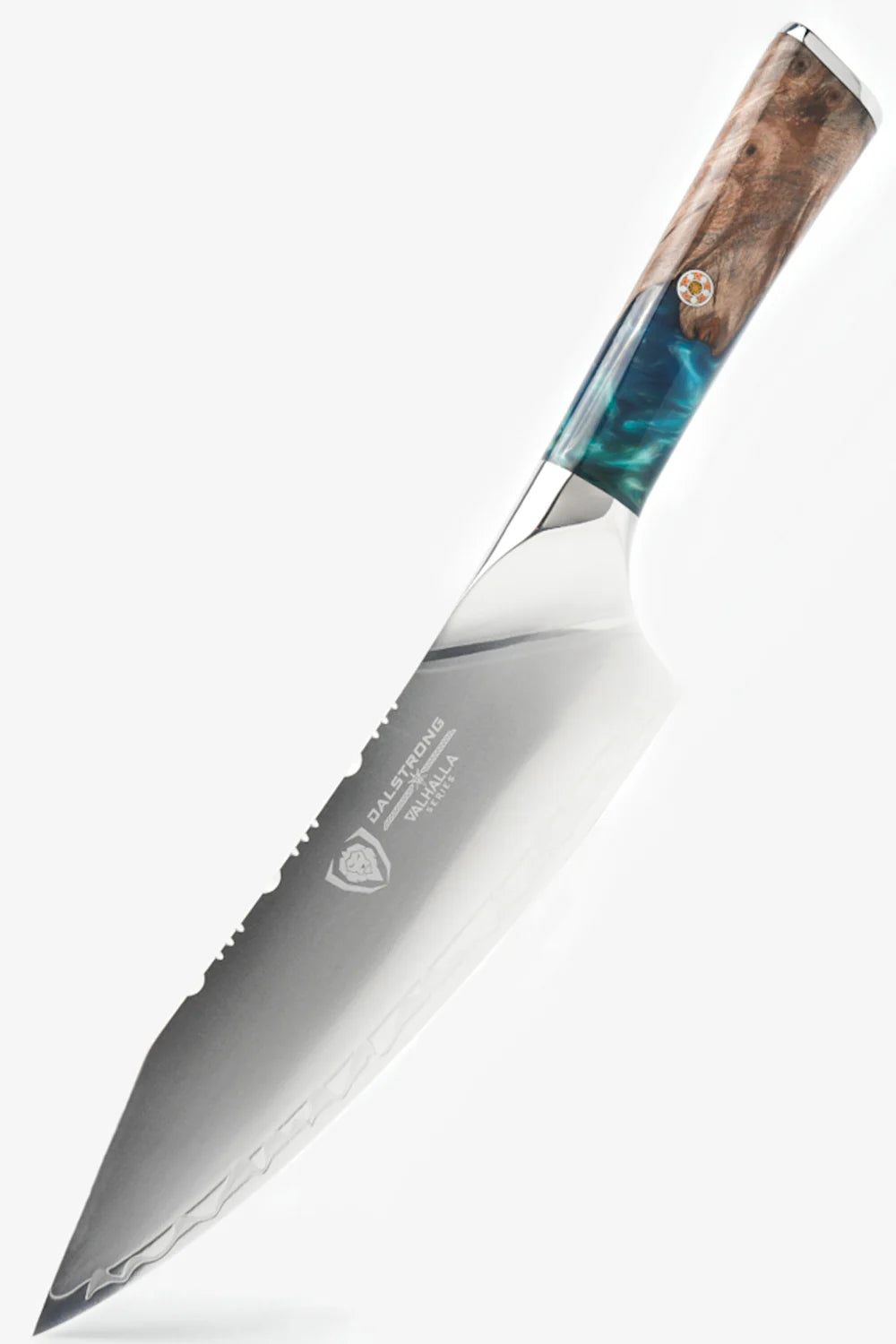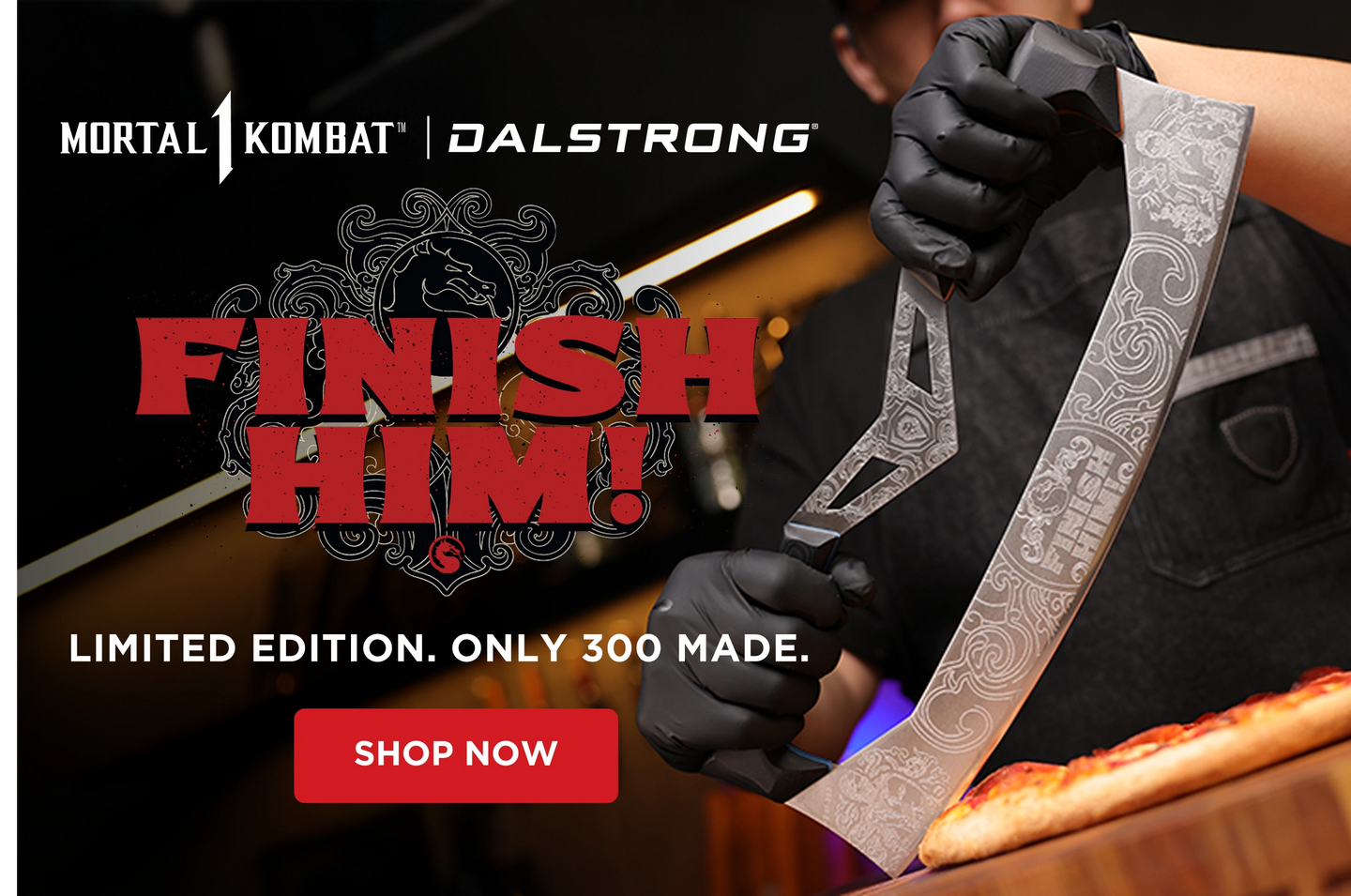Teak Wooden Cutting Board | Dalstrong ©
While both cutting board materials have their value, it is widely recognized that wooden cutting boards are a better quality and safer option. Though a plastic cutting board is cheaper and lighter to carry, bacteria grows more easily on its surface and scratch marks appear more frequently. Wooden cutting boards are more expensive, but you don't need to replace them as often.
8'' Bread Knife | Frost Fire Series | Dalstrong ©
For an outsider, it may seem as though plastic cutting board sets are more practical and convenient. But are they really, in the long term? Wooden cutting boards are one of the best investments you can make for your kitchen, and one that you’ll only need to make once. They are safe, elegant, efficient, resistant, durable and keep your knife sharp for longer.
Content Table
- What To Consider When Buying Cutting Boards
- Plastic Cutting Boards: Pros And Cons
- Wood Cutting Boards: Pros And Cons
- Recommended Cutting Boards
- Frequently Asked Questions About Plastic Cutting Boards
Why is it that you take a fair amount of time to discuss the advantages and disadvantages of buying a certain model of, say, a chef’s knife - or, why do you treat your favorite china as kitchen royalty; but then neglect essential, valuable resources like a cutting board?
When I say “you” I mean us, because somehow we’ve all been there: buying the cheapest cutting board sets at the supermarket, like this purchase will not make a difference in our kitchen.
And the cheapest cutting board will often be a brilliant colored flexible plastic cutting board, or a wooden cutting board of which we know nothing about except that the price was convenient. It’s time we learn the difference between wood, plastic and other materials; and what they can offer us in terms of food safety and efficiency.
Spoiler alert: the cheapest option is not the best cutting board in the long term. Keep reading!
1. What to consider when buying cutting boards
What is it made of?
Material is often the most distinctive feature of a cutting board, the one that makes it different from other types.
Today, the three main choices are wood cutting boards, plastic cutting boards and bamboo cutting boards. Less frequently, you can find stone, slate, granite, marble, rubber and glass cutting boards.
Wooden cutting boards can be made of teak, maple, walnut, cherry or beech. They are elegant, sturdy and safe. Flexible plastic cutting boards are cheaper and lighter; but their surface can accumulate bacteria quite easily. Bamboo cutting boards are cheap and safe; but they will quickly take a toll on your knives.
Is it easy to clean?
Cutting boards can get messy. After all, their job is to contain all the evidence from the “crime scenes” committed in the kitchen. You will be doing all the heavy work, from boning a chicken to slicing tomatoes and strawberries. Things will splash, spill and stain; maybe several times a day, every day.
So consider how much effort and time you want to dedicate to keeping your cutting board clean. Look for characteristics that make them easy to clean and maintain.
Is it large enough?A small cutting board will be easy to handle, move and store. Perfect for small foods. Other tasks will require a bigger surface; like cuts of meat or larger vegetables. Large cutting boards also double as serving boards (I love serving food on my wooden board). So ideally, you can have two or three cutting boards in different sizes depending on the occasion.
Will it be nice to your knives?
One of the things you should consider is the relationship a cutting board has with a knife. A hard surface, like a bamboo board, can really dull and damage your blades. So, if you own a good set of kitchen knives, please DO invest in a good cutting board, which is sturdy enough, but not too hard. Teak cutting boards are usually kind to blades.
Does it cover all your needs?If you’re into cooking and spend a lot of time in the kitchen, it’s likely that only one cutting board won’t cover all your needs. If you’re in a position to own several cutting boards, do it!
You can have a small or medium-sized flexible plastic cutting board of your favorite color, and use it for when you go camping or as a plan B. You can have an eye-catching glass or marble board and use it to serve food to your guests. And you can invest in one high-quality wood cutting board and cherish it as your main board.
Also, for a chopping board to have you covered; you should look into its “extras” or complementary features, like a juice groove to retain all the liquids coming from certain foods. A non-slip base is also nice to have and can prevent unwanted accidents.
2. Plastic Cutting Boards: Pros And Cons
Plastic cutting boards are one of the most commonly used surfaces for meal preparation. They can be useful for quick and easy cutting tasks, like slicing a lemon or chopping an onion for your sandwich.
You can find plastic boards in very diverse presentations with different sizes, shapes, textures, designs and colors. The best plastic cutting boards are made of polypropylene or high-density polyethylene (HDPE cutting boards), but they are also available in standard polyethylene.
Virgin high-density polyethylene is considered safe for food contact by the FDA. However, there has always been some controversy regarding plastic boards and food safety, since plastic gets easily scratched by kitchen knives and bacteria accumulate in the crevices.
PROS
- They are usually small and lightweight (easy to handle, move and store)
- Plastic is relatively friendly to your knife.
- They are dishwasher safe.
- They are cheaper than other materials and come in various designs.
CONS
- Plastic cutting boards are prone to develop scratches on the surface, where bacteria proliferate. When this happens, complete hygiene and food safety can’t be guaranteed.
- They deteriorate easily. Especially if you put them in the dishwasher too often.
- Because of the two reasons mentioned above, it’s likely you have to throw out and replace your plastic board often. So maybe, in the long term, you are not really saving money by buying plastic cutting boards.
- They are light in weight, so they can move or slide when you’re working on them; which might be dangerous considering you’re working with a sharp knife.
- Even though they offer visual variety, plastic is not as elegant as other materials.
3. Wood Cutting Boards: Pros And Cons
Wood is widely accepted as the best material for cutting boards. The best woods for cutting boards include maple, beech, birch, teak, walnut and pine.
Wooden cutting boards also offer different styles, shapes, sizes, manufacturing processes, finishes and prices. They can offer extra features and accessories. Overall, they are elegant and charming.
When discussing cutting boards made of wood, you should note that they can also be classified according to the way it was manufactured in end-grain and edge-grain.
End grain cutting boards are made from end pieces of wood. You can recognize them by the distinctive checkerboard pattern. They are usually thick, very durable and resistant to warping. They can be more expensive because of their “self-healing” ability: wood fibers will close up again after being cut by your knife. Heavy-duty butcher blocks are almost always made of end-grain wood.- If you take care of them, a wood cutting board is an investment you only need to make once, unlike plastic. These boards can withstand heavy daily use and pass from one generation to the next.
- Wooden boards keep their natural charm over time and some say that just like wine, they only get better with age.
- Wood chopping boards are safe and hygienic. Bacteria have difficulty surviving on their surface.
- End-grain cutting boards especially are friendly to the knife edge.
- Many of these boards are multifunctional and can be used as serving plates for cheese and cold cuts, for example.
- Overall they have the necessary sturdiness of a work surface, the softness to protect your knife, and the food safety we want in a kitchen tool.
CONS
- Wood cutting boards do require some degree of maintenance to preserve their advantages.
- They can’t be put in the dishwasher.
- They are heavier than plastic boards.
4. Recommended Cutting Boards
1. Corner Cutting Board - Teak WoodThe ingenuous design of this board makes it the clever choice. It can easily fit into any corner of your countertop, saving and adding space at the same time. It has a stabilizing block at the base to make sure it’s firm and stable in its place. Crafted with Dalstrong’s 100% sustainably sourced tropical teak wood.
PROS:- The special “corner block” design is not a common benefit among cutting boards.
- High-quality, durable, moisture-resistant wood.
- It will not damage your knife.
- Hygienic and anti-bacterial properties.
CONS:
- Taking care of this board is easy, but you can’t skip or forget some basic maintenance steps; like oiling once a month. So make sure you have the availability.
- There is no doubt the price is fair for the quality and features; but it might be out of budget for some.
2. Lionswood Teak Cutting Board ( Medium)
This tropical teak cutting board is just right in every way. Not too small and not too massive, just the right size to work comfortably while still being easy to store. Classic looking, yet beautiful enough to become your favorite serving plate. Feels luxurious; yet practical. It’s also sustainably sourced, hand-crafted and filled with rich moisturizing oils.
PROS:- The end-grain wood checkered construction offers multiple advantages already: Resistant to warping and slipping, it will keep your kitchen knives sharper for longer and is easy to clean.
- Manageable size. Easy to store.
- Satin-finished steel handles on the sides, so this one can double as a beautiful serving board.
- There’s a cut-out on the underside to accommodate a plate.
- For some kitchens, this may be the perfect-sized board. Others may need a bigger one.
- It’s not dishwasher-safe, in case you are a dishwasher fan.
3. Lionswood Colossal Teak Cutting Board (XL)
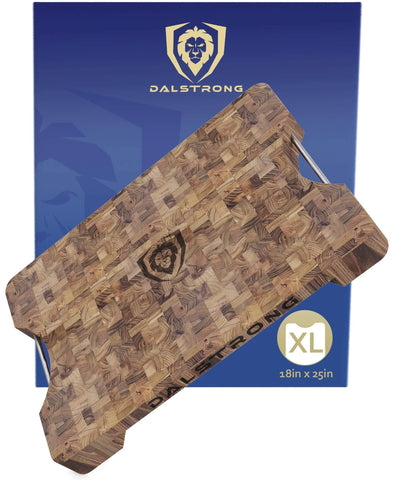
If size was a problem for you on our previous recommendation, it won’t be a problem with this one. It is very similar in looks and properties to Dalstrong’s classic teak cutting board; except that this one is massive and will become an extension of your kitchen.
PROS:
- You can cut, chop and serve; all on this cutting board, because the size allows it.
- Teak is naturally water-resistant.
- End-grain, which means your knife is safe here.
- Hygienic and easy to clean.
- Side handles and underside compartment.
- Big enough to act like a butcher’s block or a big plate for several entrées / appetizers.
- Size is only a pro if you have the space. Otherwise, it’s definitely a con.
- It’s not exactly “lightweight”. Consider this if you’re going to carry it around a lot.
4. Teak Cutting Board | Large Size | Horizontal Grain

This large board is efficient and robust, with the perfect amount of space to perform everything from the most mundane to the most elaborate cutting tasks. Crafted from natural teak wood.
PROS
- Hard enough for safe, precise cuts.
- … Yet, it is not so hard that it will damage your kitchen knives.
- Measuring lines on the underside are very useful for calculating sizes and portions.
- Juice Groove to collect food juices.
- It also serves as a presentation and serving board because it’s so elegant.
- Good value for money.
CONS
- This wood requires regular treatment with mineral oil. It’s not a difficult or time-demanding task, but something to consider.
- The size is not ideal for very small kitchens.
- It is not very practical to carry this large board for travel or use away from your home collection.
5. Teak Cutting Board | Medium Size
Would you look at those patterns? It’s difficult not to appreciate the contrasts and tones of natural teak wood with this board. It features all the advantages of end-grain wood at a more manageable medium size, perfect for essential food prep.
PROS- Compact, dense grain to ensure a strong, durable cutting board.
- Laser engraved measuring lines that will not fade over time.
- It features an anti-spill groove.
- Non-slip feet to keep the board steady on the countertop.
- Naturally resistant to water and stains.
CONS
- Some cooks will prefer a larger cutting surface.
- It does not have the steel handles as seen in other cutting boards on this list.
5. Frequently Asked Questions About Plastic Cutting Boards
Can you put a cutting board in the dishwasher?
Depending on the material, not all cutting boards can be put in the dishwasher. Wooden boards are better cleaned by hand; while plastic boards are usually dishwasher safe.
Do chefs use plastic cutting boards in a professional kitchen?
Most chefs prefer wood cutting boards for all the reasons mentioned above. However, it is not uncommon to find plastic cutting boards as extras or wildcards in commercial kitchens.































































